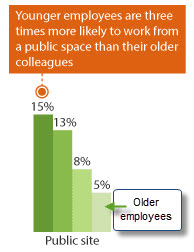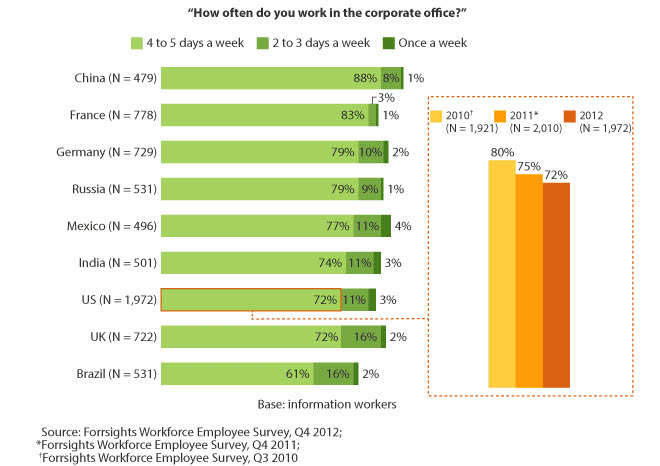Embrace Workplace And Workspace Diversity Now
 As I sit at my kitchen table enjoying the quiet of my house before my kids come home, I know that I will move to my office and shut the door once that tranquility is shattered by their arrival. Then later this evening, once the house is again quiet with the monsters nestled in their beds, I might just take a few calls propped up on pillows in my bed. Yes, I do that regularly. Heck, they call it a laptop, right? This is the "home" scenario. On the road, workplaces and spaces vary even more. I really work best from a hotel room, or the hotel bar if I have a good headset on. None of this is new for me; I have played the role of an itinerant worker for years. But for a long time my employers continued to put my name on a door or cubicle. For me, that has now changed. No more nameplate for me. Employers are increasingly waking up to the fact that many employees (or "information workers," ugh… hate the term) just don't need or even want a fixed office or space. And, likely more importantly, the employers don't want that either. An empty office is an under-optimized asset. Both demand-side and supply-side forces converge to drive workplace and space diversity.
As I sit at my kitchen table enjoying the quiet of my house before my kids come home, I know that I will move to my office and shut the door once that tranquility is shattered by their arrival. Then later this evening, once the house is again quiet with the monsters nestled in their beds, I might just take a few calls propped up on pillows in my bed. Yes, I do that regularly. Heck, they call it a laptop, right? This is the "home" scenario. On the road, workplaces and spaces vary even more. I really work best from a hotel room, or the hotel bar if I have a good headset on. None of this is new for me; I have played the role of an itinerant worker for years. But for a long time my employers continued to put my name on a door or cubicle. For me, that has now changed. No more nameplate for me. Employers are increasingly waking up to the fact that many employees (or "information workers," ugh… hate the term) just don't need or even want a fixed office or space. And, likely more importantly, the employers don't want that either. An empty office is an under-optimized asset. Both demand-side and supply-side forces converge to drive workplace and space diversity.
We hear a lot about empowered employees these days, and the changing nature of work and the workforce. Forrester's Workforce Employee Surveys investigate trends among information workers such as device usage, collaboration practices, workplace preferences, and attitudes about their employers. And, the signs are clearly indicating that the demand for workplace diversity and choice is on the rise:
- Retiring baby boomers will leave the workplace at a steady pace (around 10,000/day in the US) . . .
- . . . making room for younger employees — who work differently (like video chatting rather than stopping by to see a colleague at their desk).
- Being well-connected and mobile is a given particularly for younger employees who often choose and purchase devices and work tools themselves.
- Employees increasingly chose their place of work — with fewer opting for the corporate office and more finding themselves working in a public place.
- Regular telework has gained mainstream acceptance; even the government is doing it.
- And, as the newest kid on the workplace block, coworking — regularly working in shared business environments as opposed to a cafe, the public library or a train station — is growing quickly.
On the office space supply side, corporate leaders are looking to optimize space and ultimately reduce their real estate assets. Why? Because at some point costs become fixed and can't be cut further. Once you don't have the space, you can get rid of the lease and the energy and maintenance costs. That drive to rationalize and consolidate is also influenced by several forces:
- Real estate prices continue to rise in "hot" central business districts despite a sluggish real estate market overall.
- New accounting regulation proposed by both the International Accounting Standards Board (IASB) and the US Financial Accounting Standards Board (FASB) will require companies to declare leased real estate as assets, making them more accountable for their return on assets.
- In the public sector, initiatives such as the US federal "Freeze the Footprint" program drive real estate consolidation.
- And, while investments in "smart" buildings go part of the way to control costs, workplace management and real estate optimization go farther.
 With fewer and fewer employees going into the corporate office, the concept of a corporate office must change. Alternatives to the corporate office must also be part of your overall workplace strategy — and not just "work from home." My new report Enabling the Workplace of the Future, Now! discusses how these trends in flexible work and cowork redefine workplace diversity.
With fewer and fewer employees going into the corporate office, the concept of a corporate office must change. Alternatives to the corporate office must also be part of your overall workplace strategy — and not just "work from home." My new report Enabling the Workplace of the Future, Now! discusses how these trends in flexible work and cowork redefine workplace diversity.
This new report fits into Forrester's "workforce experience," which includes a call for CIOs to champion a more engaging employee experience.
We look forward to hearing how workplace (and space) fit into your way of working as well as your ways of enabling a better employee experience. Good workers are hard to come by. Finding and keeping them should be top of mind!